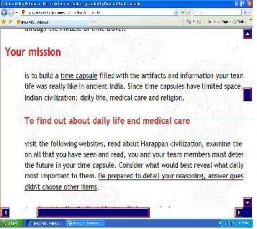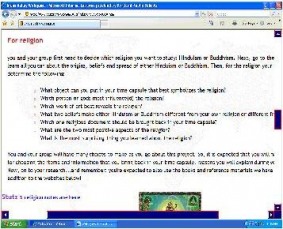Indus Valley WebQuest Evaluation
http://www.stutzfamily.com/mrstutz/indus/IndusWebquest.htm
Also absent is an explanation of the curriculum standards targeted by this WebQuest. Major national standards that correlate with Michigan’s Grade Level Content Expectations (GLCEs) are addressed nonetheless. For example, this task fulfills GLCEs regarding the origins and beliefs of major world religions. Although it states that “each research team will focus on…the origins, beliefs, and spread of” Buddhism or Hinduism, I was unable to find a requirement about the spread of religion articulated in the student tasks and, therefore, added an additional element addressing this standard when adapting the WebQuest for use in my own seventh grade class. Another modification that I implemented, in order to improve student engagement and increase technological literacy skills, was the change from a physical time capsule to the creation of a digital time capsule, thus integrating technology in the synthesis phase as well as in the acquisition of information.
Technically speaking, the Indus Valley WebQuest works. A manageable number of working links guide student research. Although some links connect to “notes” pages that, unless used with assistive technology such as a voice reader, offer little advantage over printed documents, other links, such as the Mohenjo-daro slideshow link, demonstrate meaningful change. The same general project could, in theory, be completed using traditional tools such as books, slide shows, and films, but the internet allows students to access resources, such as artifacts, that would simply be unavailable in most schools.
Technology also provides the advantage of flexibility, allowing individuals and groups to move at their own pace, access resources from alternate sites, and access interactive materials. Differentiation may occur in several ways, such as use of assistive technology, assignment of roles within groups, and differentiation according to student interests. For example, students choose whether to investigate Hinduism or Buddhism for the religion section of the activity. My first-hand experience was that this WebQuest also differentiates by ability as it sets floors rather than ceilings for student achievement. Furthermore, I found that students naturally rose to their own zone of proximal development as a result of the structure of this activity. Overall, the Indus Valley WebQuest is an effective, student-centered tool for involving students in meaningful inquiry, developing higher order thinking skills, and improving student engagement.
Tomlin, R. and Kaplan, S. (2002). John Muir Middle School. Original URL:
http://www.california.com/~tomlinr/lesson-template1.htm. Retrieved January 27, 2009 from
http://www.stutzfamily.com/mrstutz/indus/IndusWebquest.htm
Image retrieved February 4, 2009 from
http://www.stutzfamily.com/mrstutz/indus/IndusWebquest.htm



